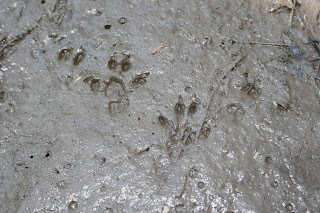Wildlife
 |
| Raccoon prints in the mud |
 |
| Black-capped Chickadee making a nest |
Downy Woodpecker
Nesting Black-capped Chickadee
American Robin
White-breasted Nuthatch
American Crow
Gull
Barred Owl
Mallard
 |
| A spider found in a culvert along Englesby Brook |
Spiders and insects:
Different spider species
Different spider species
Water Strider
Dragonfly larva
Snow Fleas (Collembola)
Firefly larva
Dragonfly larva
Snow Fleas (Collembola)
Firefly larva
Mammals:
Domestic Dog
Woodchuck
Woodchuck
Fox
Grey Squirrel
 |
| Garlic Mustard, an invasive herbaceous plant |
Raccoon
Muskrat
Fish and amphibians:
Dace Fish
Green Frog
Plants
Trees and Shrubs:
American Elm (Ulmus americana)
American Beech (Fagus grandifolia)
Eastern Hemlock (Tsuga canadensis)
Eastern White Pine (Pinus strobus)
Eastern White Pine (Pinus strobus)
Yellow Birch (Betula alleghaniensis)
White Birch (Betula papyrifera)
Musclewood (Carpinus caroliniana)
Hophornbeam (Ostrya virginiana)
Oaks (Quercus sp.)
Ash (Fraxinus sp.)
Sensitive Fern (Onoclea sensibilis)
Bloodroot (Sanguinaria canadensis)
Red Maple (Acer rubrum)
Sugar Maple (Acer saccharum)
Striped Maple (Acer pensylvanicum)
Boxelder Maple (Acer negundo)
Norway Maple (Acer platanoides)
Striped Maple (Acer pensylvanicum)
Boxelder Maple (Acer negundo)
Norway Maple (Acer platanoides)
Cottonwood (Populus sp.)
Butternut (Juglans cinera)
Black Locust (Robinia pseudoacacia)
American Basswood (Tilia americana)Musclewood (Carpinus caroliniana)
Hophornbeam (Ostrya virginiana)
Oaks (Quercus sp.)
Ash (Fraxinus sp.)
Bitternut Hickory (Carya cordiformis)
Black Cherry (Prunus serotina)
Herbs:
Garlic Mustard (Alliaria petiolata)
Japanese Knotweed (Fallopia japonica)
Ostrich Fern (Matteuccia struthiopteris)Sensitive Fern (Onoclea sensibilis)
Bloodroot (Sanguinaria canadensis)
Crescent Woods
Englesby Magnetism
Iron bacteria is a group of about 18 different types of aerobic bacteria that derive their energy from feeding on dissolved ferrous iron. In the process, they excrete insoluble ferric oxide - a reddish-orange, gelatinous slime that appears at the surface of groundwater seeps, in streams, and also in domestic water wells and plumbing. Englesby Brook features some notable colonies of these iron bacteria, and one neighbor of the brook shared stories of using magnets to collect the iron deposits generated by the naturally-occurring micro-residents of the Englesby. This idea inspired a catchy, organic marketing slogan for the subject of our study: "Englesby Brook... it's magnetic."
 |
| Firefly larva |
 |
| Flowering Bloodroot |
 |
| Red Fox scat??? |
 |
| Ostrich Fern fiddleheads |
 |
| Mallard pair |
 |
| Mayfly |
 |
| Red Admiral |
 |
| Interesting tracks |
 |
| Muskrat tracks |
 |
| Near-flowering Trout Lily |
 |
| White-throated Sparrow |

